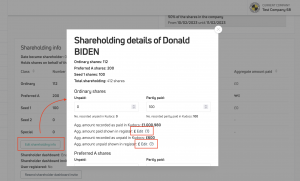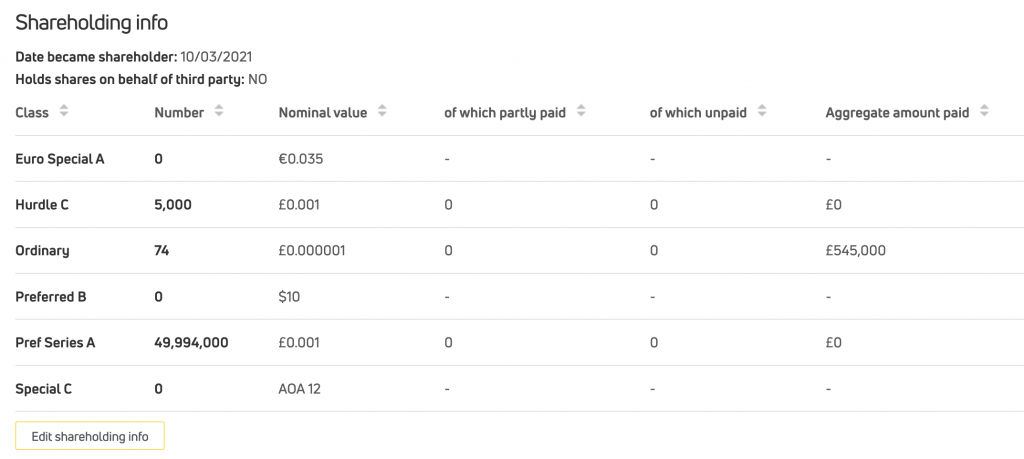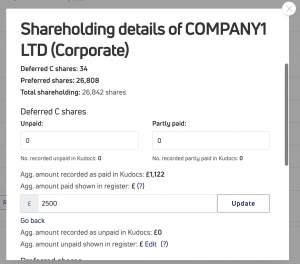Aggregate amount paid for shares
What is the aggregate amount paid and why does it matter?
The Companies Act 2006 defines what a company with shares needs to show on its register of members (ie shareholders). This includes name and address, membership start date (and end date if they are no longer a shareholder) and details about the shares they own.
Section 113(3)(b) states that the register should show “the amount paid or agreed to be considered as paid on the shares of each member.” This is known as the aggregate amount paid.
The aggregate amount is the total amount paid for the shares to the company – i.e. nominal amount + share premium. Therefore the register is required to show what was paid for the shares when they were first issued. This means that after each share transaction that might change this, you are meant to update the aggregate amount paid. This includes if shares were partially paid when first issued, and then additional payments have been paid: the company is required to update the registers as those additional payments are made – to keep the registers up to date and accurate.
The requirement is to show the amount paid for the shares when first issued, but also to show that against each shareholder in the register and, we believe, ‘follow’ the shares if they are transferred or redesignated. This seems odd as shares are not uniquely identified, but that appears to be the wording of the act and professional consensus.
For example, when shares are transferred:
(i) the amount paid for the shares being transferred should move from the transferor’s entry in the register to the transferee’s entry – as the shares now belong to them.
(ii) the amount paid for the shares when transferred is not relevant – that is a payment between the transferee and transferor, not the company.
This means that the company is required, in essence, to identify how much was paid to the company for each share the shareholder owns. Even if that means going back through multiple shareholdings to find the ‘source’ share issue.
e.g.
- A paid £100 (nominal and premium) for 100 shares issued to her.
- A transfers 50 shares to B for £3,000.
- Assuming they have no other shares, the aggregate amount paid for the shares by each shareholder should show in the register as £50 for A and £50 for B. The fact that B paid £3,000 to A for 50 shares is not relevant for the aggregate amount paid for the shares – it is the amount paid for the shares when those shares were first issued.
- B is then issued 60 shares for £2,500 (nominal and premium).
- The aggregate amount paid for the shares by each shareholder should show in the register as £50 for A and £2,550 for B (£50 for the shares transferred from A + £2,500 for the shares issued to B).
- And so on.
This is also the case where shares are redesignated from one class to another. The amount paid for the shares when first issued, should ‘follow’ the shares when they are redesignated.
I’ve received an email from Kudocs telling me to “check & update aggregate amounts paid/unpaid” after completing a share transaction. What does this mean/ what do I need to do?
As explained elsewhere on this page, a company is required to keep updated information about how much was paid for the shares held by each shareholder (Section 113(3)(b)). Following a share transaction, that information may need to be updated. Kudocs sends you this email to remind you about this.
The aggregate amount un/paid showing in the register of members is not correct. Why & how do I fix it?
Kudocs is able to provide the aggregate amount un/paid for any shares issued after the company joined Kudocs and are recorded in Kudocs. This is what is shown in the lines “Agg. amount recorded as paid in Kudocs:” and “Agg. amount recorded as unpaid in Kudocs:“(Shareholder page > scroll down to Shareholding info > {Edit shareholding info}).

For more info, see here.
However, this may not be the full total or accurate as Kudocs does not know the aggregate amount un/paid for shares issued before joining Kudocs.
e.g.
- When a company joins Kudocs, shareholder G has 1,000 shares.
- Kudocs uses Companies House data to obtain information about G as part of the onboarding process. Companies House informs Kudocs about G’s name and number of shares held. It does not tell us about how much was paid for the 1,000 shares held by G.
- G may have been issued all 1,000 shares for £1 each – so the aggregate amount paid would be £1,000.
- Or maybe they were issued at £1 each, but G only paid £0.50 for the shares (ie partly paid) – so the aggregate amount would be £500.
- Or maybe G was issued 300 shares at £1, and received 700 shares by transfer from shareholder F – so the aggregate amount paid would be £300 plus whatever F paid for the shares, etc.
- The company then uses Kudocs to issue new shares to G – 100 shares at £3/share, but only £2 is paid. Kudocs knows therefore that the total amount paid is £200 (100 x £2) and the total amount unpaid is £100 (100 x £1), but as it does not know how much was paid/ unpaid on the shares before the company was added to Kudocs it cannot complete the total amounts un/paid.
As the information about “amount paid per shareholder” is not provided to Companies House, it cannot be provided to Kudocs.
In addition, because shares can be transferred between shareholders, Kudocs does not know the aggregate amount paid for shares after a transfer has taken place.
e.g.
- A company incorporates using Kudocs with 1 shareholder with 100 fully paid shares at £1/share.
- The company then issues 50 more shares to that shareholder partly paid at £0.50/share.
- The shareholder transfers 75 shares to someone else. Kudocs does not require you to identify which shares were transferred, so they could be some or all of the partly paid shares, or all of the fully paid shares.
- Therefore Kudocs cannot automatically follow the aggregate amount paid for shares, even after incorporation. The system can suggest what information it has stored, but cannot automatically apply that for each shareholder.
Therefore Kudocs does not automatically show the aggregate amount un/paid in the registers, so the value in “Agg. amount un/paid shown in register:” may not be correct. You need to confirm the amount to show on the register, taking into consideration the aggregate amount paid to the company for all the shares held by the shareholder – both issued before and after joining Kudocs.


The total amount paid for a share class is not showing correctly in the confirmation statement. Why & how do I fix it?
This is the same issue as explained above about the register of members. Kudocs pulls through all the total amounts paid/ unpaid from each shareholder and totals them for the confirmation statement filing. If the total you see in the confirmation statement process is not correct, it is because the amount paid/ unpaid at the shareholder level is not correct. See here for how to edit shareholder details (including aggregate amount paid).